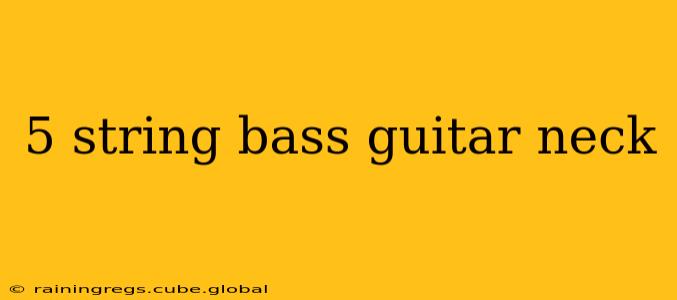The five-string bass guitar has become increasingly popular among bassists, expanding the sonic landscape and offering greater compositional possibilities. But the heart of any bass, five-string or otherwise, lies in its neck. Choosing the right 5-string bass guitar neck is crucial for playability, tone, and overall feel. This guide will delve into the intricacies of 5-string bass guitar necks, exploring construction, wood types, scale lengths, and more, answering questions frequently asked by players and enthusiasts.
What Makes a 5-String Bass Neck Different?
The most obvious difference is the addition of a fifth string, usually a low B. This necessitates a wider neck than its four-string counterpart to accommodate the wider spacing between strings. This wider spacing can impact fretting, especially for players transitioning from a four-string. The increased tension from the low B string also puts additional stress on the neck, requiring robust construction and potentially affecting the choice of wood.
What Wood is Best for a 5-String Bass Neck?
The wood chosen for a bass neck significantly influences its tone, feel, and durability. Several popular options exist, each with its own characteristics:
-
Maple: Known for its bright, clear tone and excellent durability. Maple necks often provide a snappy attack and a well-defined low end. They can feel slightly stiffer than other woods.
-
Mahogany: Offers a warmer, richer tone with a more pronounced midrange. Mahogany necks tend to be more comfortable to play due to their slightly softer feel compared to maple.
-
Walnut: A versatile wood offering a balance between the brightness of maple and the warmth of mahogany. Walnut necks often provide a robust low end with a smooth, even tone across the frequency spectrum.
-
Ebony: A dense hardwood prized for its incredible durability and smooth feel. Ebony necks often produce a tight, focused tone with excellent sustain. It is often used for fretboards rather than the entire neck.
The best wood ultimately depends on personal preference and desired tonal characteristics. Many manufacturers combine wood types, such as a maple neck with a rosewood or ebony fretboard, to achieve a specific tonal profile.
What is the Scale Length of a Typical 5-String Bass Neck?
Scale length refers to the distance between the nut (where the strings begin) and the bridge (where the strings end). The standard scale length for a 5-string bass is typically around 34 inches, although variations exist, such as 35-inch scale lengths, which offer tighter string tension and a potentially more powerful low B. Longer scale lengths generally provide improved string definition and reduced string buzz, particularly beneficial for the lower strings. Shorter scales can be more comfortable for some players.
What is the Best Neck Profile for a 5-String Bass?
Neck profile refers to the shape of the neck's cross-section. Common profiles include:
-
C-Shape: A rounded profile reminiscent of the letter "C," often considered comfortable for a wide range of players.
-
D-Shape: A thicker, more substantial profile, often preferred by players who like a more substantial feel in their hand.
-
U-Shape: A very thick profile, more characteristic of vintage basses.
-
V-Shape: A very pronounced and thin profile that is usually found on older vintage basses and can be very comfortable for players with larger hands.
The ideal neck profile depends largely on individual hand size and playing style. Consider trying out different profiles before making a purchase if possible.
How Do I Choose the Right 5-String Bass Neck for My Playing Style?
Consider these factors when choosing a 5-string bass neck:
-
Playing style: Are you playing slap bass, fingerstyle, or a combination of techniques? Different playing styles may necessitate different neck profiles and wood types.
-
Hand size: A larger hand may accommodate a thicker neck, while a smaller hand might prefer a thinner profile.
-
Desired tone: Do you prefer a bright, snappy tone or a warmer, richer tone? The choice of wood will significantly influence this.
-
Budget: Necks can range widely in price depending on the wood, construction, and manufacturer.
What are the Common Problems with 5-String Bass Necks?
Due to the increased tension from the low B string, 5-string bass necks can be prone to warping or neck dive. High-quality construction and materials are essential to mitigate these issues. Regular maintenance, including appropriate humidity control, also helps.
How Much Does a 5-String Bass Neck Cost?
The cost of a 5-string bass neck varies dramatically depending on factors such as wood type, construction, and brand. Prices can range from a few hundred dollars for more budget-friendly options to several thousand dollars for high-end custom necks.
By carefully considering these factors, you can select a 5-string bass neck that optimizes your playing experience and delivers the tone you desire. Remember that the best neck is subjective, and what works for one player might not work for another. Hands-on experience is invaluable in finding the perfect fit.
